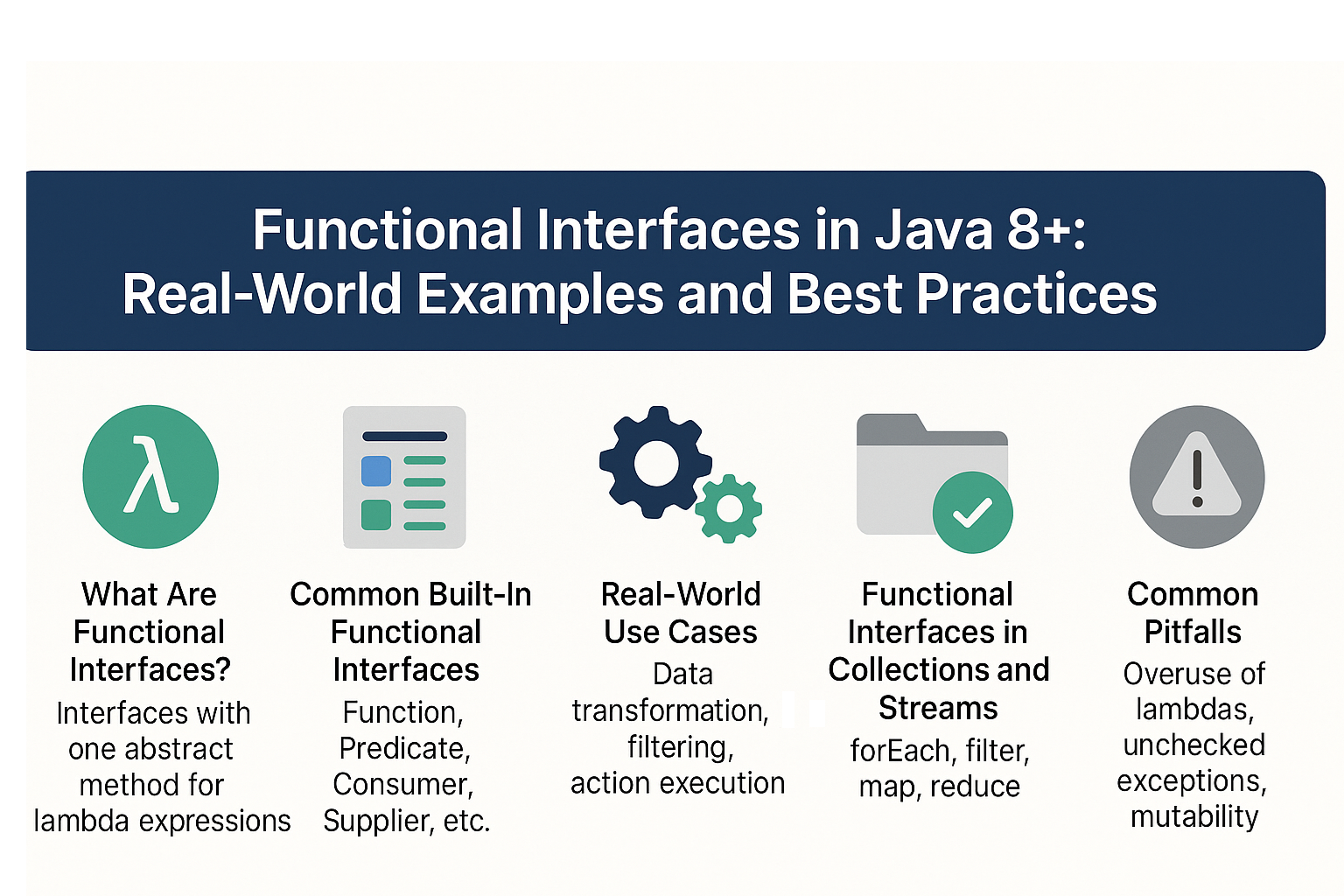Functional interfaces form the backbone of functional programming in Java. With the release of Java 8, developers gained powerful tools like Function, Predicate, Consumer, and Supplier—allowing behavior to be passed around like objects.
This tutorial dives into real-world applications of these interfaces, how to avoid common mistakes, and how to integrate them into production-ready codebases.
🚀 What Are Functional Interfaces?
A functional interface is an interface with just one abstract method (SAM - Single Abstract Method). They are designed to be implemented using lambda expressions, method references, or anonymous classes.
Example:
@FunctionalInterface
interface Greeting {
void sayHello(String name);
}
Greeting greet = name -> System.out.println("Hello " + name);
greet.sayHello("Alice");
Java provides a suite of pre-built functional interfaces in the java.util.function package.
🔧 Common Built-In Functional Interfaces
| Interface | Description | Method Signature |
|---|---|---|
| Function<T,R> | Transforms T to R | R apply(T t) |
| Predicate |
Returns true/false based on condition | boolean test(T t) |
| Consumer |
Performs action on T, returns nothing | void accept(T t) |
| Supplier |
Produces T, takes nothing | T get() |
| UnaryOperator | Function<T, T> (same type input/output) | T apply(T t) |
| BinaryOperator | Function<T, T, T> (2 inputs, 1 output) | T apply(T t1, T t2) |
💡 Real-World Use Cases
1. Using Function<T, R> to Transform Data
Function<String, Integer> lengthFn = s -> s.length();
System.out.println(lengthFn.apply("Lambda")); // 6
Use case: Mapping DTOs to entities, parsing, validation pipelines.
2. Filtering with Predicate<T>
List<String> fruits = List.of("Apple", "Avocado", "Banana");
Predicate<String> startsWithA = s -> s.startsWith("A");
fruits.stream().filter(startsWithA).forEach(System.out::println);
Use case: Conditional checks, validation, input filtering.
3. Performing Actions with Consumer<T>
Consumer<String> printer = System.out::println;
printer.accept("Hello from Consumer!");
Use case: Logging, sending notifications, UI updates.
4. Supplying Data with Supplier<T>
Supplier<String> randomId = () -> UUID.randomUUID().toString();
System.out.println("Generated ID: " + randomId.get());
Use case: Lazy initialization, ID generators, default value suppliers.
5. Composing Function with andThen() and compose()
Function<String, String> trim = String::trim;
Function<String, String> toUpper = String::toUpperCase;
Function<String, String> pipeline = trim.andThen(toUpper);
System.out.println(pipeline.apply(" hello ")); // HELLO
🎯 Functional Interfaces in Collections and Streams
forEach→Consumer<T>filter→Predicate<T>map→Function<T, R>reduce→BinaryOperator<T>
List.of("One", "Two", "Three")
.stream()
.filter(s -> s.length() > 3)
.map(String::toUpperCase)
.forEach(System.out::println);
⚠️ Common Pitfalls
- Overusing lambdas where clarity is lost
- Ignoring checked exceptions (must be handled manually)
- Mutating external variables inside lambdas
- Excessive chaining without proper naming
🧰 Creating Custom Functional Interfaces
@FunctionalInterface
interface Validator<T> {
boolean validate(T t);
}
Validator<String> emailValidator = email -> email.contains("@");
Use @FunctionalInterface annotation for compile-time safety.
🔒 Thread Safety and Side Effects
Functional interfaces are not thread-safe by default. Avoid shared state or use synchronization when needed.
📌 What's New in Java Versions?
Java 8
- Introduced
java.util.function, streams, lambdas
Java 9
Optional.ifPresentOrElse,FlowAPI
Java 11
- Local variable inference in lambdas with
var
Java 17
- Sealed interfaces enhance functional modeling
Java 21
- Structured concurrency, virtual threads, scoped values
🧱 Functional Patterns Using Lambdas
- Strategy Pattern: Injecting behavior via
Function - Command Pattern:
Runnableor custom functional interfaces - Builder Pattern: Lambdas for configuration steps
- Observer Pattern:
Consumer<T>as event handlers
✅ Conclusion and Key Takeaways
- Functional interfaces enable powerful, expressive coding in Java
java.util.functionoffers flexible, reusable patterns- Use lambdas where clarity improves, but prefer named functions for complex chains
- Functional programming boosts composability and reduces boilerplate
❓ FAQ
1. Are functional interfaces only usable with lambdas?
No, they can also be implemented with anonymous classes and method references.
2. Can a functional interface have default methods?
Yes. Only one abstract method is allowed, but multiple default or static methods are fine.
3. How do I handle exceptions in functional interfaces?
Wrap them using try/catch or helper utilities like Try.of() from Vavr.
4. Can I return a lambda from a method?
Absolutely. Lambdas are just implementations of interfaces.
5. Are lambdas memory-efficient?
Yes. JVM can optimize them using invokedynamic, but be mindful of capturing state.
6. Can I use var in lambdas?
Yes, from Java 11 onwards ((var s) -> s.length()).
7. When should I prefer method references over lambdas?
Use them when you’re simply delegating to an existing method—makes code cleaner.
8. Are functional interfaces thread-safe?
Not inherently. Avoid shared mutable state.
9. Can functional interfaces be generic?
Yes, Function<T, R> is a prime example.
10. Do lambdas improve performance?
They improve readability more than performance. But they can reduce boilerplate and improve clarity.
